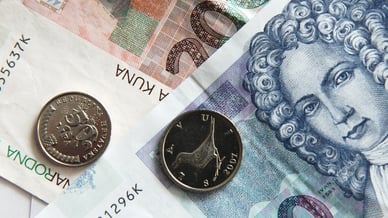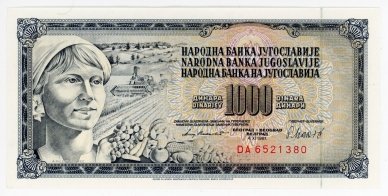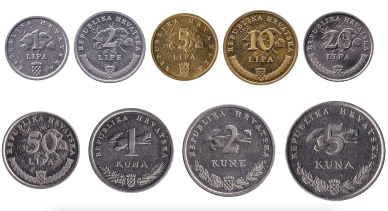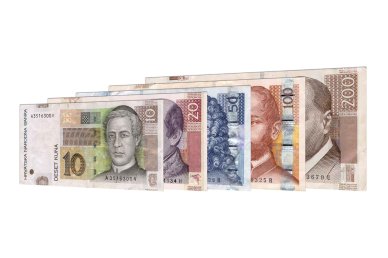The Croatian Kuna

The Croatian kuna (Kn, HRK) was the official currency of the Republic of Croatia. It was not a reserve currency and did not circulate in other countries.

History
The kuna had been the official means of payment in Croatia two times. First, it was during the period of World War II when the country was under the pro-fascist regime of Ante Pavelic from 1941-1945. The second circulation began in 1994 when the republic seceded from the Socialist Federal Republic of Yugoslavia and continued up to a certain date.
The kuna's predecessors were the coins of countries existing on the Croatian territory in the Middle Ages. Between the 16th century and 1918, the krone, as the currency of the Austro-Hungarian Empire, circulated within the lands of Croatia.
When World War I ended with the defeat and collapse of the Habsburg Monarchy, Croatia, together with the other two Balkan states, founded the Kingdom of Serbs, Croats, and Slovenes. The dinar became the currency of this new country and remained legal tender until 1941.
After World War II, several Balkan republics united into the Socialist Federal Republic of Yugoslavia. The Yugoslav dinar circulated as the official currency until 1991.

1000 Dinara - Yugoslavia (1981)
At the beginning of the 1990s, internal conflicts intensified in Yugoslavia. This led to the war between the federal republics. Croatia was the first to secede from the SFR Yugoslavia and introduced a temporary currency called the Croatian dinar that circulated until May 1994. From May 30, 1994, to June 30, 1995, there was a gradual exchange of the dinar to the kuna with the rate of 1,000:1.
The kuna became the permanent currency of the republic on July 1, 1995. The word ‘kuna’ stems from the word ‘marten’, which means an animal whose skins used to be one of the means of payment and exchange within the Slavic tribes.
One Croatian kuna was divided into 100 lipa (fractional coins).
Design
In Croatia, the money that was in circulation included banknotes, mono- and bimetallic coins. Metallic money was minted every year. Citizens used the coins of 1 Kn, 2 Kn, and 5 Kn, and the fractional currency of 10, 20, and 50 lipa. The coins were covered with alloys of aluminum and magnesium, copper and nickel, and laminated steel, and had a diameter that ranged from 16 mm to 26.5 mm.

Croatian kuna coins
The reverse sides featured crops like corn, olives, tobacco, grapes, and also oak, and degenia. The coins of 1 Kn, 2 Kn, and 5 Kn depicted a nightingale, a tuna, and a bear.
One-, two-, and five-lipa coins had lost their purchasing power.
Coins were also released to commemorate various events that took place in Croatia. Namely, there were 25-lipa bimetallic coins, coins made of precious metals, silver coins of 100 Kn, 150 Kn, and 200 Kn. The coins in the largest denominations of 500 Kn and 1,000 Kn were made of gold.
Banknotes
Paper money of Croatia was issued in eight denominations from 5 Kn to 1,000 Kn. They were of the same size and color. The obverse featured the country’s political and religious figures who had greatly contributed to its development and prominent Croatian poets and philosophers.

Croatian kuna banknotes
The reverse sides depicted architecture and statues of distinguished Croats.
- 5 Kn was a green banknote that measured 122 mm by 61 mm. There was the portrait of Petar Zrinski and Fran Frankopan on the obverse, and Varaždin Castle on the reverse.
- 10 Kn was a banknote of different colors that depended on the year of issuance. It might have been violet (1994), brown and gray (1997, 2001, 2004, 2013). The obverse featured Juraj Dobrila, and the reverse showed the Pula Arena. The note measured 126 mm by 63 mm.
- 20 Kn was a red banknote that measured 130 mm by 65 mm. It featured Josip Jelačić on the obverse and a palace in Vukovar and Vučedol Dove on the reverse.
- 50 HRK was a dark blue banknote that measured 134 mm by 67 mm. It featured the portrait of Ivan Gundulić on the obverse and historical regions of Dubrovnik on the reverse.
- 100 HRK was an orange banknote that featured the poet Ivan Mažuranić and the Baška tablet on the obverse and a cathedral in Rijeka on the reverse.
- 200 HRK was a brown banknote that measured 142 mm by 71 mm. The obverse depicted Stjepan Radić, and the reverse showed the fortress in Osijek.
- 500 HRK was an olive green banknote that measured 146 mm by 73 mm. The obverse depicted Marko Marulić, and the reverse featured the statue of one of the Croatian kings in the background of Diocletian’s Palace.
- 1000 HRK was a blue-violet-gray banknote that measured 150 mm by 75 mm. It featured the portrait of Ante Starčević on the obverse and the statue of King Tomislav and the Zagreb Cathedral on the reverse.
The Croatian National Bank provided the money issuance. The coinage was produced by the Croatian Monetary Institute. The German company Giesecke & Devrient was responsible for the printing of the kuna banknotes.
The Croatian Kuna in the World
This currency was almost never used in foreign exchange transactions, and it was not included in the list of freely convertible currencies. The kuna exchange rate was highly dependent on the tendencies of the global economy. The HRK-USD exchange rate had remained 6-7:1 for several years, whereas the HRK-EUR had been 0.13:1.
Transition to the Euro

Croatia made the decision to adopt the Euro as its official currency, phasing out the Croatian kuna. This significant change occurred due to a combination of economic, political, and strategic considerations. Being part of the European Union, the shift towards the Euro aimed to integrate Croatia more closely with its European partners, facilitating trade and investments while promoting stability and growth in the region. The adoption of the Euro also marked Croatia's commitment to the shared European values and economic convergence with the Eurozone.
The official transition to the new currency took place on January 1, 2023.
FAQ
What is the Croatian kuna?
The Croatian kuna (Kn, HRK) was the official currency of the Republic of Croatia.
What were the different types of Croatian kuna?
The kuna has been the official means of payment in Croatia two times: first during World War II under the regime of Ante Pavelic (1941-1945), and the second circulation began in 1994 after Croatia seceded from the Socialist Federal Republic of Yugoslavia.
Who was depicted on Croatian kuna banknotes?
Croatian kuna banknotes featured the country’s political and religious figures, prominent Croatian poets, and philosophers such as Petar Zrinski, Fran Frankopan, Juraj Dobrila, Josip Jelačić, Ivan Gundulić, Ivan Mažuranić, Stjepan Radić, Marko Marulić, and Ante Starčević.
Was the Croatian kuna a stable currency?
The Croatian kuna's exchange rate was influenced by global economic tendencies. Specific stability would require deeper analysis, but it experienced periods of stability as indicated by the HRK-USD and HRK-EUR exchange rates mentioned.
When was the Croatian kuna replaced by the euro?
The official transition from the Croatian kuna to the euro took place on January 1, 2023.
What were the denominations of the different types of Croatian kunas?
The denominations of the Croatian kuna banknotes and coins were as follows:
Banknotes:
- 5 Kn
- 10 Kn
- 20 Kn
- 50 Kn (or 50 HRK)
- 100 Kn (or 100 HRK)
- 200 Kn (or 200 HRK)
- 500 Kn (or 500 HRK)
- 1000 Kn (or 1000 HRK)
Coins:
- 1 Kn
- 2 Kn
- 5 Kn
- Fractional currency (lipa): 10 lipa, 20 lipa, and 50 lipa.
- Commemorative and special coins: 25-lipa bimetallic coins, silver coins of 100 Kn, 150 Kn, and 200 Kn, and gold coins in denominations of 500 Kn and 1,000 Kn.
Note: The "Kn" stands for kuna, and "HRK" is its international currency code. "Lipa" is the subunit of the kuna, with 100 lipa equaling 1 kuna.
